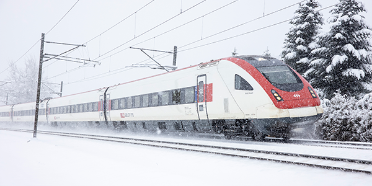Onboard monitoring on tilting trains using simple sensors
Safe rail operations involving high-speed cornering depend on an infrastructure in good and safe condition. In future, this will be permanently monitored in commercial operations with the new Onboard Monitoring System.
Factsheet
- Lead school School of Engineering and Computer Science
- Institute Institute for Intelligent Industrial Systems (I3S)
- Research unit I3S / Prozessoptimierung in der Fertigung
- Funding organisation Innosuisse
- Duration 01.06.2017 - 31.12.2023
- Project management Prof. Dr. Axel Fuerst
- Head of project Simon Walther
-
Project staff
Simon Müller
Matthias Steck
Marcel-David Zwahlen
Adrian Roger Hofer - Partner SBB AG
- Keywords Onboard monitoring, tilting train, force prediction, simple sensor technology, machine learning
Situation
In order to be able to handle rail traffic safely and reliably, the infrastructure must be in a condition that meets the requirements, not only for conventional passenger rail traffic but also for the high-speed tilting trains that push the system to its limits. If a tilting train is approved for high-speed cornering on a particular line, the interaction of the vehicle with the track must be checked periodically for each type of tilting train running on the line. The vehicle reactions measured must be documented, and any safety-relevant incidents examined. According to applicable regulations, the measurement of contact forces and guiding forces on the wheels with measuring wheelsets (MRS) is mandatory. These permit reproducible measurements of wheel-rail forces for the assessment of rail safety (the sum of lateral forces for safety with respect to track displacement, and the ratio of guiding force to wheel contact force for safety with respect to derailment), but are complex and correspondingly cost-intensive.
Course of action
To create an operable, cost-effective measurement technology, the project developed a concept in collaboration with SBB to discover how all assessment variables required by the applicable regulations, i.e. also those with force limit values, can be covered solely using a simple sensor system. A simple sensor system comprises sensors such as acceleration or displacement sensors. Measurement data from comprehensive inspection runs with a tilting train equipped with both measuring wheelsets and simple sensors were used for the analyses. In the first phase, after processing the measurement data, the prescribed assessment variables were analysed as to their relevance. It was found that the sum of the lateral forces (derived from the track displacement resistance) is the most critical factor in the high-speed cornering of rail traffic. In the second phase, the researchers turned to machine learning algorithms for help in converting the lateral accelerations (also factoring in the vertical accelerations in the carriage body) into the sum of the lateral forces ΣY and consequently the single guiding force Y. Machine learning makes it possible to go beyond the linear relationship of mass, acceleration and force and also deal with non-linearities of the moving train as a mass-spring-damper system. Additionally, for the all-round monitoring of vehicle safety, primary spring deflections were transferred to vertical forces on the wheel to derive information on the wheel contact force.
Result
The newly found solution delivers good results with the existing data. The methodology includes complete pre-processing in line with the applicable guidelines as well as the direct data transfer from HDF5 files. Multiple sensitivity analyses demonstrated the high stability of the machine learning algorithm with respect to the main influencing factors of the train such as load, speed and route. Besides the robust algorithm, the data used and the data quality are also important. The collaboration between BFH and SBB also determined the most meaningful and stable metrics, giving the system additional stability. All metrics used have an influence that can be explained in physical terms and reliably measured. In this way, it was possible to develop a functioning, operationally stable concept for a simple sensor system for the tilting trains that is resource-efficient with regard to life-cycle costs.
Looking ahead
This methodology will now be finally validated by BFH. The validation process will also involve the use of the methodology on journeys in commercial operations. Furthermore, the stability under these circumstances will be examined. On conclusion of the project, SBB will apply for approval of this methodology. One tilting train per fleet is to be equipped with a functioning, operationally reliable onboard monitoring system based on simple sensor technology that is resource-efficient in terms of life-cycle costs. The measured data will be sent to a central computer and processed off-board in an automated data management system. Compliance with the regulatory limits will be verified as part of the automated railway infrastructure monitoring, so that track maintenance measures can also be triggered, as necessary.


